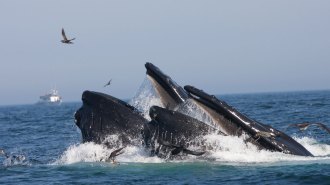Search Results
All about outliers
Students will define what an outlier is and discuss why outliers occur, how to identify them and how they can be useful for science and society.

Whales Eat More Than We Thought
In this guide, students will learn how scientists estimated the food intake of certain whale species and discuss nutrient cycling and conservation of matter within ecosystems.
Cycling through an ecosystem
Students will discuss nutrient cycling and conservation of matter, and how these concepts can be observed in an ecosystem.
Rethinking whale appetites
Students will answer questions about the online Science News article “Baleen whales eat (and poop) a lot more than we realized,” which details scientists’ efforts to accurately estimate how much certain whale species eat and what that means for ecosystems. A version of the article, “Whales eat more than we thought,” appears in the December 4, 2021 issue of Science News.
Think like a science journalist
Students will learn how science journalists develop stories from scientific studies by analyzing a Science News article and the study on which it is based. Then, students will use a scientific study provided by the teacher to write their own news article.
- Exercise type:Activity
- Topic:Health & Medicine
- Category:Coronavirus
- Category:Data Analysis
- Category:Diversity in STEM
A fair shot
Students will analyze a graph to identify inequities in COVID-19 vaccine access among nations based on wealth, discuss how affluence affects access to and distribution of vaccines as well as how disparities in vaccine distribution affect global pandemic recovery. Students will then work in groups to research COVID-19 vaccine access and distribution in their state or local area, identify potential inequities in vaccine access and distribution and construct a graph of their own.
Investigating invasive species
Students will define invasive species and discuss how certain species affect ecosystems and human society. Then, students will research invasive species in their region and devise an invasiveness rating scale.
Science mystery solvers
Students will answer questions about the online Science News article “A toxin behind mysterious eagle die-offs may have finally been found,” which explores scientists’ quest to ID a suspect in mass bird deaths. A version of the story, “Elusive killer in eagle die-offs ID’d,” appears in the April 24, 2021 issue of Science News.
Planning ahead to prevent future disasters
Students will take on the role of a planning board for a region identified as having an increased risk for natural hazards — wildfires, floods, droughts, heatwaves or hurricanes — due to climate change. After proposing regulations and other strategies to reduce the natural hazard’s impact, the students will discuss the merits of the proposed solutions before voting on a disaster plan and budget for their region.
- Exercise type:Activity
- Topic:Science & Society
- Category:Research & Design
- Category:Diversity in STEM
Diversity in science
Students will explore diversity in the STEM community and discuss how future textbooks might highlight the scientific contributions of the women who won the 2020 Nobel Prize in chemistry. Students also will research and present on the achievements of women in STEM throughout history.
Pandemic reflection
Students will review a timeline of major events related to the COVID-19 pandemic and discuss lingering questions about the pandemic. With a partner, students will reflect on how the pandemic has affected their life and what changes the near future may bring.
The joy of science
Students will answer questions about the online Science News article “From Elvis worms to the Milky Way’s edge, these science stories sparked joy in 2020,” which summarizes Science News stories from 2020 that provided a happy distraction from the world’s worries. A version of the story, “Stories that sparked joy,” can be found in the December 19, 2020 & January 2, 2021 issue of Science News.